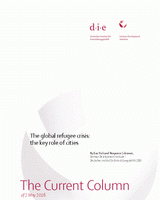The global refugee crisis: The key role of cities
Dick, Eva / Benjamin SchravenThe Current Column (2016)
Bonn: German Development Institute / Deutsches Institut für Entwicklungspolitik (DIE) (The Current Column of 2 May 2016)
Bonn, 2 May 2016. According to the United Nations Refugee Agency (UNHCR), there were over 60 million displaced persons worldwide in 2015, a figure unparalleled since 1945. Although it is often assumed in Germany and Europe that most of these individuals are really headed for Europe, more than 80 % of them are found in developing countries and emerging economies, with the majority displaced within their own nations. Syria and its neighbouring countries are worst affected, but displacement is also a significant issue in Colombia, Nigeria and Sudan. Contrary to popular belief, it is cities rather than refugee camps that receive most of these displaced persons. Consequently, it is necessary to take greater account of this urban dimension to the refugee crisis in efforts to support refugees and their host communities.
Most refugees and displaced persons are heading for cities
The World Migration Report 2015 of the International Organization for Migration (IOM) states that two thirds of all displaced persons worldwide are found in urban areas. By contrast, the proportion of refugees staying in camps is comparatively low in most countries. For instance, it is just 20 % in Jordan and a mere 10 % in Lebanon. In many cases, cities serve as stop-off points for individuals on their way to regional and international destinations. Whether as destinations or places of transit, people make their way to cities in the hope of finding security, basic supplies and work, which makes cities strategic ports of call. According to the IOM, most of the refugees in these urban centres live in existing residential areas, either renting accommodation or staying with relatives and acquaintances. They frequently reside in informal urban settlements, as in the case of Jordan, where there are some 200,000 refugees living in such areas.
While geographical segregation is less of an issue within well-established urban structures than in refugee camps, cities in developing countries and emerging economies, which are taking in a large number of refugees, are facing major challenges. These include the provision of basic services in the areas of education, training, health care, accommodation, technical infrastructure and access to em-ployment (which is often made more difficult by legal and social issues), as well as the need to ensure that the different population groups can co-exist peacefully. And these issues are exacerbated by the very limited technical and financial capacity of most local governments and administrations, and by their lack of involvement in migration policy decisions. Likewise, there tend to be few opportunities for refugees to engage in the political process.
Placing a greater (development policy) focus on the urban dimension
German and international development cooperation organisations are already working in the main host and transit countries to support projects and initiatives in cities and municipalities, and in refugee camps which have developed into quasi cities. Their activities include the (re)construction of schools, pre-schools and hospitals, initiatives to improve energy and water supplies, the promotion of school and training systems for children and young people with accompanying psychosocial support, and measures to improve access to financial services. If we are to increase the long-term benefits for both refugees and local populations, then we need to give greater consideration to the challenges and consequences facing cities:
Local level: local governments, city governments and administrations should be involved from the outset in measures to support refugees and displaced persons. To this end, there is an urgent need for national governments to supply these local authorities with the requisite financial resources. Addi-tionally, technical expertise must be developed, for instance in order to aid local infrastructure plan-ning. Finally, civil society organisations and networks, including networks between refugees and the local population, should also be incorporated into partnerships alongside state partners.
Social cohesion: given the frequent potential for conflict between refugees/displaced persons and native population groups, any investments, including those in local infrastructure, should provide benefits to the local population from the word go. There is also a need in many cases for conflict management and initiatives for preventing urban violence, for example, among young people.
From management to design: refugee camps are set up to provide short-term, stop-gap solutions for the groups concerned. However, they often become long-term institutions, turning into cities of sorts, but without proper urban structures. Refugee camps should therefore be built or restructured with the aim of enabling people to reside there in dignity and to take control of their own lives. Refugees need employment prospects and the opportunity to play an active role in shaping everyday life in the camps.
By taking greater account of these urban challenges, we could make a decisive contribution to promoting security, democracy and better living conditions in the countries affected by the global refugee crisis.


